Asda hires Matmi for first viral push
Posted in: UncategorizedLONDON – Supermarket giant Asda will launch its first viral marketing campaign next month, after hiring digital agency Matmi.
LONDON – Supermarket giant Asda will launch its first viral marketing campaign next month, after hiring digital agency Matmi.
LONDON – JCDecaux Airport has appointed Redbus Outdoor’s Nicola Greene to head its experiential division Sphere.
LONDON – UK ad spend on radio is forecast to double this year as falling audience figures allow analogue stations to increase advertising costs, according to a forecast from WPP’s GroupM.
LONDON – Ink Publishing has secured an exclusive contract with EasyJet to sell ambient media such as aeroplane seat ads and ticket promotions for the budget carrier.
LONDON – Aegis agency Diffiniti beat off the challenge of three agencies to land Sky’s prized £23.5m digital media account, previously held by I-Level.
LONDON – Telegraph Media Group has poached Barry Flanigan, director of marketing and communications at AOL, to become its new marketing director.
LONDON – Adnams is to axe its board-level marketing director post once the current incumbent Steve Curzon leaves in March.
LONDON Cashless payment scheme Oyster is to launch an additional method for touching in and out of London public transport later this year in the form of a wristwatch.
LONDON – The Department for Children, Schools and Families (DCSF) is gearing up to launch its first marketing campaign aimed at tackling underage binge-drinking.
LONDON – Asda is planning a multimillion-pound relaunch of its website as part of a long-term strategy to give UK shoppers the ‘ultimate online retail experience’.
LONDON – Aegis agency Diffiniti beat off the challenge of three agencies to land Sky’s prized £23.5m digital media account, previously held by I-Level.
SINGAPORE – Aviva has awarded a digital advertising brief for the 2008 Aviva Ironman triathlon in Singapore to Proximity after a round of pitching with OgilvyOne.
It is an aged rum. The copy in Spanish reads: Qué rico es tomarse el tiempo. It has a double meaning:
1. It is great to pass time relaxed enjoying yourself.
2. It is nice to take the time (an aged rum).
Advertising Agency: Olabuenaga Chemistri, Mexico
VP Creative: Jorge Cuchi
Group Creative Director: Pablo Ferrari
Ass. Creative Director: Hugo Castillo
Art Directors: Gert Kiebooms, Héctor ColÃn
Copywriter: Natividad Gidi
Photographer: Dominó / Uruguay
Published: December 2007
It is an aged rum. The copy in Spanish reads: Qué rico es tomarse el tiempo. It has a double meaning:
1. It is great to pass time relaxed enjoying yourself.
2. It is nice to take the time (an aged rum).
Advertising Agency: Olabuenaga Chemistri, Mexico
VP Creative: Jorge Cuchi
Group Creative Director: Pablo Ferrari
Ass. Creative Director: Hugo Castillo
Art Directors: Gert Kiebooms, Héctor ColÃn
Copywriter: Natividad Gidi
Photographer: Dominó / Uruguay
Published: December 2007
 (TrendHunter.com) OK boys, listen up, it’s time you stopped counting on the ladies to care for birth control. No more excuses that you’re not willing up to give up your manhood for good; there is now a reversible vasectomy… and it’s controlled by radio.
(TrendHunter.com) OK boys, listen up, it’s time you stopped counting on the ladies to care for birth control. No more excuses that you’re not willing up to give up your manhood for good; there is now a reversible vasectomy… and it’s controlled by radio.
The contraceptive implant is being developed in Australia. Un…
KUALA LUMPUR – Digi Telecommunications has awarded its RM45 million (US14 million) youth and Malay marketing account to Grey after a five-way pitch.
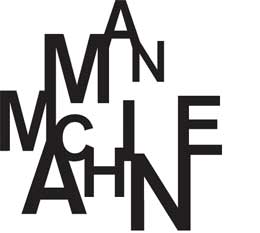 Last week (or was it two weeks ago already?) i was in beautiful Stockholm to visit the Man Machine 2 exhibition, produced at the Interactive Institute and curated by Björn Norberg.
Last week (or was it two weeks ago already?) i was in beautiful Stockholm to visit the Man Machine 2 exhibition, produced at the Interactive Institute and curated by Björn Norberg.
What makes the show particularly interesting was the whole production process. It all started from scratch, only a few months before the opening of the exhibition, with a brainstorming where contemporary artists Matti Kallioinen, Ebba Matz and Christian Partos shared views and experience with engineers. The questions the discussion focused on revolved around the way we use the machine and how the human mind and body have interplayed with the machine historically and how man and machine will interact in the future.
After that the artists got the opportunity to have a peak inside the National Museum of Science and Technology‘s storage facility (usually closed to the public). Going from shelf to shelf the artists got to know the story of some of the artefacts belonging to the Museum’s collection and were invited to position this technological cultural heritage in relation to their own artistic expression. Throughout the process the artists were in constant dialog with engineers, the Interacting Institute and the curators from the National Museum of Science and Technology.
Which brings me to another peculiarity of the show: it takes place inside a museum of technology. Not an art gallery, nor a contemporary art museum. This situation reflects one of the Interactive Institute’s missions: to bring media art and interactive pieces outside of its usual territory and give it a broader audience.
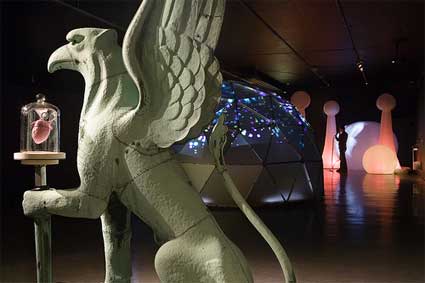
Photo Truls Nord
The artists were asked to choose one artefact each out of the collection. Partos chose a pacemaker, Kallioinen a wooden bellows and Matz a perpetuum mobile.
What i also found worth noting is that. if Christian Partos is used to work with technology Kallioinen and Matz were less familiar with it.
“One important thing with the “Man Machine concept” has been to create a platform where artist and engineer meet, exchange ideas and solve problem together,” Björn Norberg, the curator of Man Machine 2, told me. “There’s a lot of inspiration from E.A.T. and Billy Klüver, the pool that matches engineers and artists. When I was given the chance for both Man Machine and Man Machine 2 and decided to take the opportunity to work with artists that I hadn’t been working with before but also to create a mix in between them, both as artists and in the knowledge about technology and the age of them.”
“If the artists are just open minded, are used to work in different materials and have a lot of ideas there will always be interesting to let them play around with technology and let them meet engineers. The knowledge about technology is then less important.”
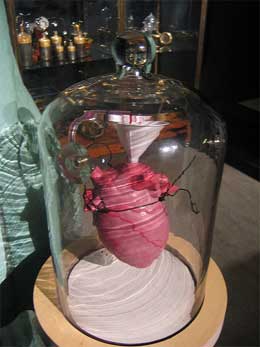 The first clinical implantation into a human of a fully implantable pacemaker was in 1958 in Solna, Sweden, using a pacemaker designed by dr Rune Elmqvist . Christian Partos’ installation has the same role as the pacemaker: it keeps a heart beating.
The first clinical implantation into a human of a fully implantable pacemaker was in 1958 in Solna, Sweden, using a pacemaker designed by dr Rune Elmqvist . Christian Partos’ installation has the same role as the pacemaker: it keeps a heart beating.
The griffins were created for the roof of the building of the national telegraph board that was located in central Stockholm but had somehow found their way to the museum’s back yard. Partos rescued them and trusted them with a display case filled with shiny objects taken from the museum’s collections. Each creature is holding a plate with a glass bell jar, one containing an ancient clock and one containing what appears to be a beating human heart. When the heart beats, is squirts out a red liquid from a tube. The liquid pours down into a small plastic funnel and from there back into the heart.
The accompanying soundscape evokes slow heart beats. It is actually made by picking up the sounds from the room and looping them back.
Video of the installation.
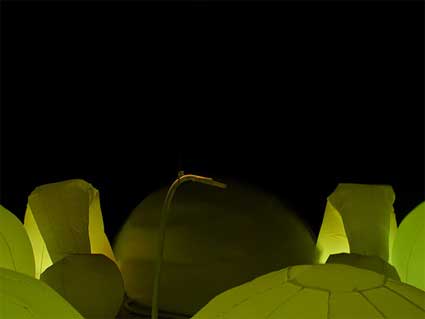
Photo Erik Sjödin
Matti Kallioinen had an idea of working with air in some way. He liked the idea that air needs to be enclosed before you can use it as a power. His choice was a wooden bellows of the type used in the old iron factories.
In his installation The Food chain and Dream World of the Organism the audience and a sophisticated sensor controlled fan construction function as bellows. Erik Sjödin has some amazing images from the installation and a performance.
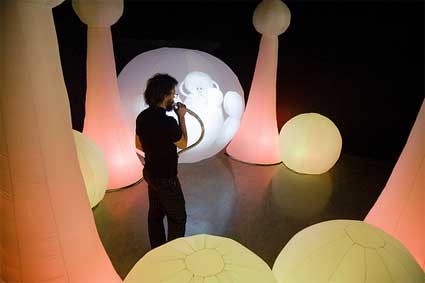
Photo Truls Nord
Visitors can pick up their own tube of plastic and use it to blow up a whole landscape of shapes in just a few seconds (ventilation fans are there to make it much easier and swifter). The landscape acts like an organism, it respond to breath by shifting in color, emitting sounds and by growing in size. After a few seconds, eerie ghost-like figures appear on the surface of the structure.
Erik Sjödin, who has worked on the installation together with the artist explains how it works:
The sound scape that surround the installation, the color of the bodies and the rate at which the colors shifts is determined by the growth of the installation and the airflow measured in the tube. The growth of the installation is monitored by five ultrasonic range sensors, its color is set by sixteen green and red lamps who illuminate the bodies from their insides. A video projection with accompanying sound fades in and out on the center sphere as it is inflated and deflated. When no one is interacting with the installation it emits ambient sounds and slowly shifts color while occasionally inflating itself slightly. A spotlight illuminates the umbilical cord so as to invite people to grab it and start interacting with the installation.
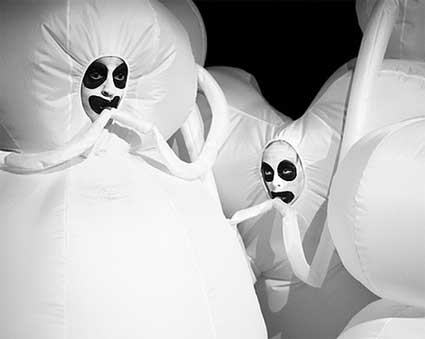
Photo Truls Nord
The performance and costumes of the ghosts were created specifically for the installation (videos from the event which took place in New York 1 and 2.)
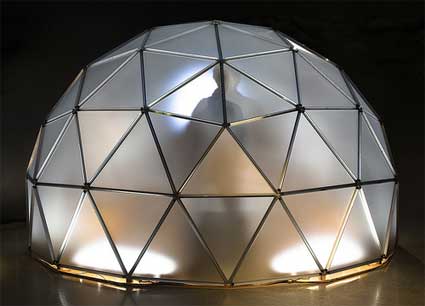
Photo Truls Nord
Swedish inventor P J Hoffring built perpetuum mobile and called it “Paradox”, alas! it hardly ever worked. His struggle to fight against the laws of nature inspired Ebba Matz’ dome in the exhibition.
Matz’ dome takes you to a journey inside a kaleidoscope. The inside is covered of mirrors and when you move inside you are surrounded by images of yourself in an endless repeat.
But the mirrors are not just mirrors. Images leaks in from the outside and are mixed with the reflection of the mirror. The mirror is not just a reflecting surface but also the boundary between outside and inside and the connection between what happens inside and what is projected from the outside.
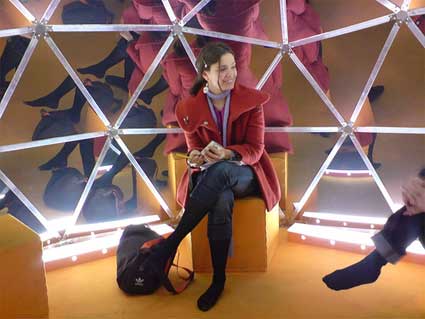
Image by Ingvar Sjöberg
Right after the pendulum, the artist`s inspiration was the Pepsi Pavilion created for the Expo ’70 in Osaka. The Pavilion’s interior dome immersed visitors in 3D images generated by mirror reflections and in spatialized electronic music.
The original structure of the pavilion consisted of a Buckminster Fuller-style geodesic dome. With some of his projects, and in particular his Dymaxion House, Buckminster Fuller was dreaming of solving the energy and housing problems for ever. Hoffring´s pendulum was also looking for the eternal solution, the one of never-ending movement.

E.A.T. – Experiments in Art and Technology, «Pepsi Pavilion for the Expo ’70», 1970
Photograph: Fujiko Nakaya | ©
All the works were built in few weeks using open source technology: Processing, Arduino, Open Framework.
My images.
The Physical Interaction Lab has some more info and videos.
Until April 28, at the Museum of Science and Technology in Stockholm. Man Machine is a part of the node.stockholm festival which runs until February 15 throughout the city.
AustralianIT reports:
ANZ is set to become the first bank in Australia to launch a mobile phone banking service and its competitors are expected to follow suit soon.
ANZ is understood to be trialling the service among a small group of customers and plans to roll out commercially in the next couple of weeks. The bank […]
 (TrendHunter.com) “Tagged in Motion†is a project created by graffiti artist DAIM, that eliminates a graffer canvas of a solid matter and unveils the ability to be able to tag in mid air, creating a virtual world of graffiti visible trough 3D glasses.
(TrendHunter.com) “Tagged in Motion†is a project created by graffiti artist DAIM, that eliminates a graffer canvas of a solid matter and unveils the ability to be able to tag in mid air, creating a virtual world of graffiti visible trough 3D glasses.
The graffiti is captured using three camcorders with motion …